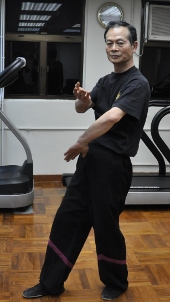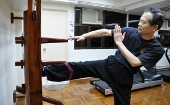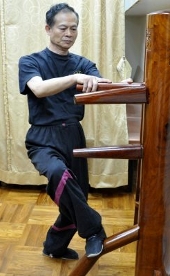詠春拳
相傳詠春拳起源於中晚滿清年代,由對南少林武功非常了解之武術大師五枚師太所創立,後傳與嚴二及嚴詠春父女,嚴詠春氏,原籍廣東,少而聰穎,行動矯捷,磊落有丈夫氣,這款名震海內外的中華武術,即成於她也,故名「詠春拳」,所謂南拳北腿,詠春拳就是中國拳術的南拳之一。
自一九四九年葉問宗師挾技來港之後,積極發揚詠春拳,在短短二十二年之時間,不但在港澳區把詠春發揚光大,更把詠春種子散落到世界每一角落,使詠春之果實牢牢散播於世界各地,他曾培養出之人才如李小龍及梁相等出色之弟子,分別都能繼承宗師遺志,把詠春拳進一步發展開去。
此拳主要手型為鳳眼拳、柳葉掌,拳術套路主要有小念頭、尋橋和標指三套拳及木人樁。基本手法以三膀手為主,還有挫手、撩手、破排手、沉橋、粘打。主要步型有三字馬、追馬、跪馬、獨立步等。它是一種集內家拳法和近打於一身的拳術。它立足於實戰,具有招式多變、運用靈活、出拳彈性,短橋窄馬,擅發寸勁為主要特點,以大閃側,小俯仰,耕攔攤膀,黏摸盪捋,審勢記牢,曲手留中的手法,以搭、截、沉、標、膀、腕指、黏、摸、熨盪、偷、漏和「二字鉗羊馬」的身形步法為標誌。憑藉橋手靈敏的感覺,發揮寸勁力量的內家拳法,武器有六點半棍、八斬刀等,六點半棍簡單好用,八斬刀法招招玄妙兇狠。近年來,詠春拳遍及美、英、法、德等60多個國家和地區,是中華武術中目前影響最大的拳種之一。
Wing Tsun
It is suggested that Wing Tsun was originated in mid/late-Qing dynasty, founded by the nun NG Mui, who had deep understanding in south Shaolin school martial arts. The skill was passed to YIM Yee and his daughter, YIM Wing-Chun. YIM Wing-Chun was born in Guangdong, well-known for her dexterity and being upstanding. The techniques in this brilliant Chinese martial art system was summarized and concluded by her, and thus named after her as "Wing Tsun". There is an idiom "Kuen(punch/hand) in the south, Tui(leg) in the north". Wing Tsun is one of the Kuen system in South China.
Since Grandmaster IP Man came to Hong Kong in 1949, he actively spread out the martial art of Wing Tsun. Within the 22 years, Wing Tsun has not only got its fame in Hong Kong and Macau, but also blossomed in every corner of the world, which build up the foundation of the development of Wing Tsun in different places in the world. He has nurtured so many outstanding martial art masters, particularly Bruce LEE and LEUNG Sheung. They followed Master Ip's will and further propagate Wing Tsun with evolution.
The hand gesture of Wing Tsun are Phoenix Eye punch and Willow palm, Main routines are Siu-Lim-Tau (little idea), Chum-Kiu (arm-seeking) and Biu-Tze (finger strikes) as well as Muk-Yan-Chong (wooden dummy). Basic hand techniques are three Bong-Sau (upper arm), together with Cho-Sau(repressing arm), Liu-Sau, Po-Pai-Sau(butterfly palm), arm-seeking, stick-and-beat. Main footwork includes character three stance, chasing stance, kneeling stance, one-foot-standing. Wing Tsun combines internal martial arts and close quarter combat skills. It is developed from praxis, hence has a great variation of movement and is high flexible. Narrow horse-stance and applying punches within inch are its main characteristics. Hand techniques are "Gaan Laan Taan Bong, Lim Mo Dong Luet" (plowing, barring, spreading, wing, sticking, touching, swaying, catching), and aiming to preparing counter strike at centreline. The main body gesture is Yee-Jee-Kim-Yeung-Ma (abduction stance), and other significant movements or footwork include bridging, chopping, pronating, sinking, darting, wing, wrist-and-finger, sticking, touching, swaying, glomming and leaking. It is an internal martial art that exploits the power of short-distance punches on the basis of the sensitivity of bridge-seeking arm. The weapons include Six-and-half-point Pole, Eight-slashing Broadswords etc. Six-and-half-point Pole is simple and convenient, while Eight-slashing Broadswords are mysterious but decisive. In recent years, Wing Tsun is spread into over 60 countries and districts including USA, UK, France and Germany. It is one of the most influential styles of Chinese martial art in the world.


